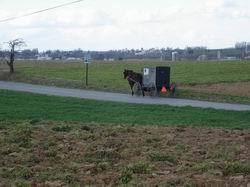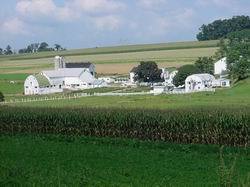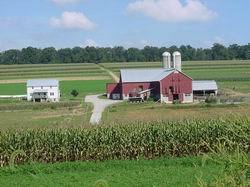About the Amish
Introduction
The Amish are a religious group who find their heritage in the Protestant Reformation. Generally, the Amish reside in close-knit communities in 47 states of the United States as well as Ontario, Canada. The Amish population continues to grow, due to large family size and a church-member retention rate of approximately 80%. The largest concentrations of Amish in the United States are in Holmes County, Ohio, LaGrange County, Indiana, and Lancaster County, Pennsylvania. By state, the largest Amish population is in Ohio, and the second largest is in Pennsylvania. There are an estimated 150,000 to 228,000 Amish in the United States in all groups, and another 1500 in Ontario,Canada.
There are as many as eight different groups within the Amish population, with the majority affiliated with one of five religious orders: Old Order Amish, New Order Amish, Andy Weaver Amish, Beachy Amish and Swartzentruber Amish. These churches operate independently from each other with differences in how they practice their religion and conduct their daily lives. The Old Order Amish are the largest group and the SwartzentruberAmish, an offshoot of the Old Order, are the most conservative.
The Amish are Anabaptists (a term which means re-baptizer)–a movement that also includes Mennonites, Brethren and others. The Anabaptists were considered radicals during the Reformation and were persecuted by both Catholics and Protestants. The Amish continue to believe in many of the conclusions of the 16th Century Anabaptists, including the concepts of individual freedom and the priesthood of all believers. They reject infant baptism and instead baptize adults upon a confession of faith. They also believe in a separation of church and state and practice pacifism. Their lives emphasize simplicity, humility, community, family and separation from the world.
History
The Amish have their roots in the Mennonite community. Mennonites were part of the early Anabaptist movement in Europe, which took place at the time of the Protestant Reformation. The Anabaptists believed that only adults who had confessed their faith should be baptized, and that they should remain separate from the larger society. Many early Anabaptists were put to death as heretics by both Catholics and Protestants, and many others fled to the mountains of Switzerland and southern Germany. Here began the Amish tradition of farming and holding their worship services in homes rather than churches.
The Amish originated in 1693 when a Swiss bishop named Jacob Amman and his followers broke from the Mennonite Church in an attempt to restore some of the early practices of the Mennonites. Amman had been an elder or bishop among the Swiss Brethren (Mennonite). Amman advocated a strong view on shunning (or the ban, which is a disassociation with members of the community who do not conform to the rules of the community–a form of discipline). The Amish and Mennonite churches still share the same beliefs concerning baptism, non-resistance, and basic Bible doctrines. They differ in matters of dress, technology, language, form of worship, and interpretation of the Bible.
Coming to North America
 The Amish who split from Mennonites generally lived in Switzerland and in the southern Rhine river region. The Amish, like the Mennonites, were persecuted for their faith throughout the 16th, 17th and 18th centuries in Europe. Many were tortured and killed. Because of this, the Amish were a quiet people and constantly on the move.
The Amish who split from Mennonites generally lived in Switzerland and in the southern Rhine river region. The Amish, like the Mennonites, were persecuted for their faith throughout the 16th, 17th and 18th centuries in Europe. Many were tortured and killed. Because of this, the Amish were a quiet people and constantly on the move.
In 1681, William Penn, an English Quaker, received ownership of the land that would eventually become the state of Pennsylvania. He decided to try a “holy experiment:” to establish a colony that would allow religious tolerance. Amish, Quakers, Mennonites, Moravians, Schwenkfelders and others in Europe responded to the opportunity by moving to the area. High taxes, high rents, inflation, wars and rumors of wars, the military draft, and religious persecution encouraged believers to leave Europe.
Amish settlers began to immigrate to Pennsylvania as early as 1720. The first sizable group of Amish arrived in Lancaster County in the 1720’s or 1730’s. A congregation was organized by 1749, when an ordained bishop named Jacob Hertzler came from Switzerland to lead the new settlers.
Waves of Amish emigrating from Europe continued throughout the 18th and 19th centuries. They settled in Lancaster County (PA), Holmes County (OH), northern Indiana and in smaller communities in Michigan, New York, Illinois, Iowa, Kansas, Nebraska, South Dakota and Ontario. Today they live in numerous states and Ontario, but the largest communities remain in Lancaster County, Holmes County, and northern Indiana. More recently some Beachy Amish have relocated in several locations in Central America in an attempt to remove themselves from the influences of modern society. There are no Amish living in Europe today.
Beliefs
Christianity
The fascination that many people (including sociologists) have with the Amish culture and lifestyle sometimes dwarfs the simple fact that the Amish are Christian. It is this simple faith that compels them to the lifestyles they choose and provides them with the hope in their salvation.
The Bible
The Bible is the sacred text of the Amish people. The Amish interpret the Bible literally and directly in many cases, which explains certain aspects of their lifestyle.

The Ordnung
In addition to the Bible, there are unwritten rules on which the Amish people base their morals and way of life. The Ordnung is an oral tradition of rules that regulates how the Amish way of life should be conducted. Specific details of the Ordnung differ among various church districts. The rules are generally reviewed biannually and occasionally revised as needed.
Simplicity
The Amish believe that at its core, faith and life are not complex. As the world around them hurries by with cell phones and PDAs in a rush to make the next sale or run the kids off to soccer games, the Amish find freedom for the mind and soul in their adherence to simplicity.
Community
While the early Anabaptists were concerned with the individual freedom of each believer, they also believed that it was important that the believer was solidly rooted in the community of faith. The Amish believe that faith finds expression in the way one treats one’s neighbors, service and mutual accountability.
Humility
The Amish believe that Jesus set an example in putting others before himself to the extent that he denied his own selfish desires. The Amish model this attitude and lifestyle.
Pacifism
The Amish take very seriously (and literally) the words of Jesus. So as Jesus commanded his followers to love their enemies and not to resist an evil person, the Amish take him at his word. During the Reformation, many Anabaptists went willingly to their graves, praying for their persecutors right up until the end. Along with pacifism come other beliefs that follow the literal words of Jesus, such as an admonition not to swear oaths.
Separation
The Amish believe that the Church was founded to bear witness to the world, but that the followers of Jesus are called to be separate from the world. They believe in remaining quite separate from the rest of the world, physically and socially. Part of this may also be caused by the belief that association with others–often referred to as “The English”–may be polluting. Part may be because of the intense persecution experienced by their ancestors as a result of government oppression.
Lifestyle

Appearance and Attire
Amish women and girls wear modest one-color dresses with long sleeves and a full skirt. They wear a cape or apron over the dress and fasten everything with pins or snaps. They do not cut their hair, which they wear up in a bun. They wear a prayer covering or bonnet on their heads. They do not wear jewelry or makeup.
Men and boys wear trousers with suspenders, solid-colored shirts, and suits or straight-cut coats of one color. They fasten their coats with hooks. They wear black socks and black or brown shoes and black or straw hats. Amish men wear beards after they are married. They do not grow mustaches because of the long association of mustaches with the military.
Education
The Amish do not value formal education. Although they pay school taxes, the Amish have fought to keep their children out of public schools. In 1972, the Supreme Court handed down a landmark unanimous decision that exempted the Old Order Amish and related groups from state compulsory attendance laws beyond the eighth grade. Amish children generally attend school through the eighth grade, often in one-room schoolhouses with a single teacher. They learn the basics of reading, writing and arithmetic. Higher education is considered unnecessary and something that can lead one away from a life of simplicity and humility as well as the community. However, the Amish know the importance of informal education, and many boys and girls learn the mechanics of farm life or other crafts at a young age.

Modern Conveniences
The Amish avoid modern conveniences as an expression of their ideals of simplicity and separation from the world. Amish homes do not draw power from the electrical grid. Generally the Amish do not use electricity in their homes at all but some have generators to run machinery for work.
With very few exceptions, Old Order Amish congregations do not allow the owning or use of automobiles or farm tractors. However, they will ride in cars when needed.
They do not have radios, TV sets, personal computers, computer games, etc. In-home telephones are not normally allowed. Some families have a phone remote from the house or shop for business purposes or use answering services.
The Amish do not take photographs or allow themselves to be photographed. To do so would be evidence of vanity and pride. Also, it might violate the prohibition in Exodus 20:4, the second of the Ten Commandments: “Thou shalt not make unto thee any graven image, or any likeness of anything that…is in the earth…”
Language
Most Amish speak three languages: Pennsylvania Dutch (Deutsch) at home or when speaking with other Amish, High German in worship, and English at school and when speaking with anyone who is not Amish.
Mutual Assistance
There is much neighboring in the Amish community, and helping each other is the most common way of socializing. The Amish carry no life or property insurance; the church assists in cases of major loss. Large families generally give assurance of care for the elderly. Only rarely do Amish retire to places other than the dawdyhaus, a small house built next to the main farm house. Retired Amish farmers do not receive Social Security.
Worship
Amish worship services are held every other Sunday morning. They are held in homes and conducted in the High German language. Services usually consist of singing, two prayers, Bible reading, a short opening sermon, and a main sermon. Singing is slow. Normally hymns are sung from the Ausbund of 1564–one of the
oldest Protestant hymnals. Worship services often last for four hours or more.
Communion services are held twice yearly in the spring and fall. Before the service, a council meeting is held in which the attendees resolve any disagreements that they have with each other. They also discuss matters regarding proper lifestyle and conduct.
The Amish celebrate the traditional Christian holy days. They also observe a Fast Day on October 11.
Marriage and Family Life

Marriages outside the faith are not allowed. Couples are married in one of their homes during November or early December, after harvest season. Tuesdays and Thursdays are the days for weddings; these are the least busy days of the week.
Divorce is not permitted and separation is very rare. They are strictly monogamous and generally patriarchal. Sex roles are clearly defined. The average family size is 7-8 children.
Funerals
Amish funerals are conducted in the home without a eulogy, flower decorations, or other display. The casket is plain, without adornment. At death, a woman is usually buried in her bridal dress. A simple tombstone is erected after burial like all the other tombstones in the Amish cemetery–in death as in life, no one person is elevated above another.
Occupation and the Philosophy of Work
Acceptable occupations in the Amish community are ones that emphasize community, do not require higher education, and avoid the use of technology, modern conveniences or labor-saving devises. Manual labor, hard work and thriftiness are virtues. A strong work ethic is certainly built into the Amish heritage.
In the past, most Amish were farmers. While many continue to farm, large tracks of land have become more difficult to acquire, and many Amish are turning to other acceptable occupations. These businesses generally involve trades that they have learned since childhood, like furniture building, quilt making or cooking. While Amish communities try to stay as isolated from the secular world as possible, the commercialization of their culture has made these products known to non-Amish consumers. The Amish dedication to hard work and the “bootstrapping” business style of the Amish community contributes to its success as members move from their farms into entrepreneurship.

